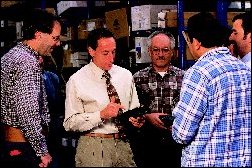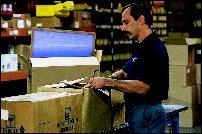
"It's a big warehouse and our dual focus is customer service and operational efficiency," says Mitchell Miller, director/operations at Torrington's Waterbury, Conn., headquarters. "Keeping costs down is managing head count, and to do that we have to be as efficient as possible."
Torrington's paperless warehouse is such a success that distributor executives from all over the country have journeyed to Waterbury to see this phenomenon that the Torrington team built.
Paperless warehouse is no misnomer; not one scrap of paper is written on or printed in the receiving or picking process. Every step is electronic - from receiving manufacturers' deliveries and putting away inventory to taking orders and scheduling deliveries.
"We learned quickly when we moved into this large warehouse that time spent walking or looking for product is unproductive and accounts for a large part of the day," Miller says. "We were flabbergasted to find that our best pickers were only on task 20% of their workday, and we had what we thought was an efficient system. So we designed this system and our product layout to reduce the walking time."
Torrington has accomplished this by narrowing the zones where material is stored as well as placing bar-code label printers and computer terminals in strategic areas of the warehouse.
"We would love to install conveyors to improve the efficiency even more, but our current warehouse setup makes that unfeasible," Miller says. "So we did the next best thing; we designed the warehouse systems around the concept that an efficient warehouse has high percentages of time on task."

Counter culture
One piece to the warehouse efficiency puzzle is the counter. Torrington has a brisk counter business, but a competing supply house is about 100 yards up the street. Customers used to complain because of the long wait times."Before we had the Eclipse warehouse management system, we had six employees at the counter," Miller explains. "They entered the orders, printed them, grabbed the pick ticket and picked the order. We have a very large warehouse; when the counterperson picked the order, it took a long time and customers were frequently unhappy."
So Torrington conducted studies to determine the actual wait time at the counter. Under the old system, the studies concluded that it typically took about four minutes per line item to pick a counter order, not including entry time. A typical four-line order would take nearly 17 minutes. In the current system, the counter people enter the order and the warehouse picks it. With three fewer people, the average time to pick an order is about 11/2 minutes per line item, and there is little, if any, waiting time to enter the order.
"Our counter picking time has dropped by two-thirds," Miller says. "We can also track counter-transaction time at the customer level, which is a good sales tool." If a customer is concerned that his employees are spending too much time waiting for orders, Miller can run a report indicating just how long his employees were at the counter.
"If a mechanic is gone from the jobsite for two hours, we don't know where he is, but he's not here," he adds.
These orders get picked so quickly because of Torrington's sophisticated warehouse system. Each order entered into the computer system, either by inside sales, the counter or by remote users on the Web, has an attached shipping code that determines the picking order. This is called the ship-via-pick priority. The first priority for pickers is a counter pickup, then emergency delivery orders, will calls, scheduled local deliveries, branch transfers and route deliveries for the following day.
The system uses radio frequency technology to immediately communicate with the picking work force. Each picker carries a portable, handheld scanning gun, which transmits data to the host computer via four antennae that are connected to the company's computer local-area network. "Everything that we scan is real time," Miller says.
Pickers are alerted when a counter sales order is entered into the picking queue by a "Charge!" tune broadcast on all the scanning guns. A picker already working in the warehouse can open a second screen on his gun for the counter order.
"The system has to keep the counter orders separate from what the picker has already selected," Miller explains, "so he can pick the order quickly."
When the order is completed, the picker can go back to the exact same location and product where he left off. The system allows pickers to go back and forth from zone orders to higher priority counter orders.
"Counter orders used to get mixed in with zone picks," Miller explains. "The system always sorts the picks by location, even when new items are added to a picking session. The ability to segregate picking sessions eliminated this problem."
Torrington's pickers get a bonus for a certain number of picks, and they get an added bonus for counter picks. "They are very fast to grab the counter picks," Miller notes.
Electronic signatures are the most recent addition to Torrington's counter. Counter staff capture customers' signatures for each order on Symbol palm computers. Several times a day the signature files are downloaded into the company's computer. The signature graphic becomes a permanent record attached to the invoice.
"This signature capture system has eliminated paper at our counters but is cumbersome," Miller notes. "Eclipse has just introduced signature pads like the big retailers, which will eliminate the scanning and downloading."
Torrington's drivers also use palm computers to obtain delivery signatures, as well as access to their delivery routes.
"The PalmPilot lists all the stops on the driver's route in delivery order," Miller says. "When a driver gets to a stop, he simply pulls the order's delivery details from the computer."
If no one is at the site, the driver notes that the material was left without a signature and enters the location. All this information becomes a permanent part of the invoice record. Signatures and time/date information have virtually eliminated proof of delivery requests and disputes over "missing" deliveries.

Night shift
Torrington has five daytime employees who pick the counter orders, emergencies, will-calls, local deliveries and branch transfers. All the route deliveries are picked at night."We started a night-picking crew to alleviate the end-of-the-day rush," Miller explains. At one time, the company had its pickers come in from 7 a.m. to 7 p.m.
"We had all our orders picked all day," he says. "Our trucks are loaded at night, so our customers know they have to place their orders for tomorrow today. On a typical day we would be caught up at 2 p.m. and hit with 1,000 to 1,200 lines between 3 and 5 p.m. No matter how hard the guys worked that day, they still had half a day's work ahead of them when the rest of the company went home."
With this rush to finish all the orders by quitting time, the packing tables became overloaded with material, Miller says. "Even though we have a very orderly system, there was confusion in the packing area, which led to some order mix-ups."
Going to a night shift, which starts at 5 p.m. and ends at 2 a.m., means that day pickers can concentrate on getting the most immediate orders out and the night pickers can concentrate on the route orders and branch transfers for the next day.
The picking process ensures the most efficient use of employees' time, Miller says. Each picker is assigned to a zone and typically selects 25 picks from multiple orders in one session. The picks are sorted by computer, which determines the shortest picking route. The picker is prompted to scan the product and location and enter the pick quantity.
Order picks are scanned into bar-coded totes. The system keeps track of which items are in which totes and automatically keeps order totes separated. In this way the picker can pick multiple parts of several orders simultaneously. When the picking session is complete, the separated order totes are then taken to the packing area for packing, routing and pre-loading.
Packers enter the package count information into the computer, which finalizes the picking process. The computer automatically assigns the order a truck route as well as a delivery and loading sequence. The packed order is then brought to the pre-loading location.

Receiving end
For all these processes to work smoothly, the inventory count must be accurate."Having product received and put away properly ensures that it will be picked and shipped properly," Miller says. "With the number of manufacturers' shipping errors we experience, our receiving people have to know the product."
Receivers scan bar codes on incoming product; about 85% of all product comes in bar coded, a significant increase from 50% in 1996, Miller says. Torrington bar codes the rest.
As each item is scanned, the quantity being received is entered into the computer. When the final product is scanned, the entire shipment is received. The receiving employee compares what has been received with what is listed on the manufacturer's packing list.
"If the packing list doesn't match what we got, we call the vendor immediately," Miller says. "At first, vendors questioned us when we said there was a discrepancy. But all our major vendors have visited our facility, and they've watched the way that we receive product. They never question us anymore; they know we're right."
The second part of the receiving function is putting away the material. Like the picking function this is done in zones. The system routes the put-away process by the most efficient path. At the designated area the item, location and quantity are scanned. If there is not enough room for all the pieces, the receiver has the option of splitting the quantity and putting part of it in another area. The system keeps track of what and how much is in every location and automatically adjusts the picking routes to where the material is.
If the total quantity put away does not match the received quantity, the computer displays an error message.
"It's a double-check," Miller says. "We have isolated problems, but generally the verification and the put-away both match."
Once the material is put away in its proper location, it is then available for sale, he explains. If the material has been received but not put away, it's not available for sale; however, inside salespeople can tell customers that the material is in the building and will go out with their orders the next day.
"If I were to ask anyone who knows our industry the benefit to a company of having an accurate inventory, knowing where things are and having all the warehouse activities automated to maximize operating efficiency by the computer, he would say almost immeasurable," Miller says. "That's what it has meant to us."

